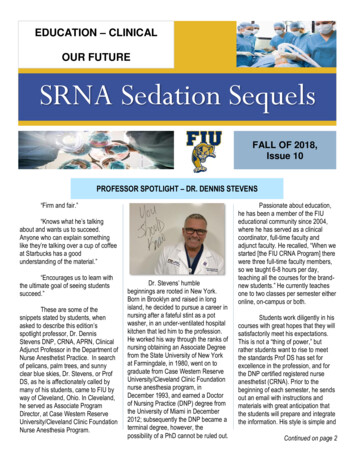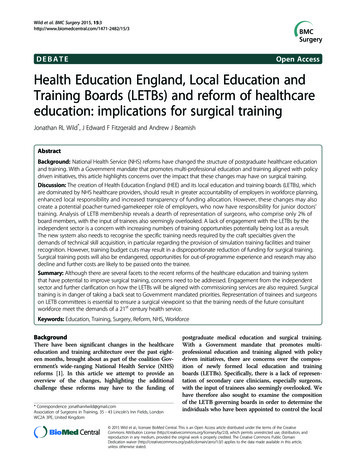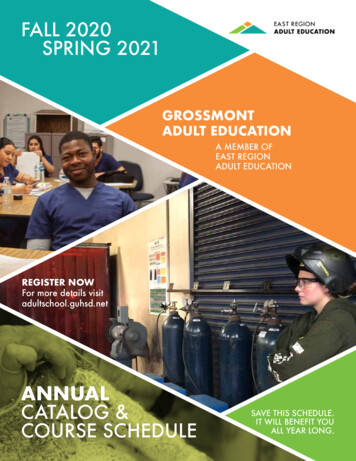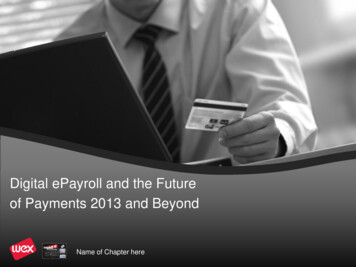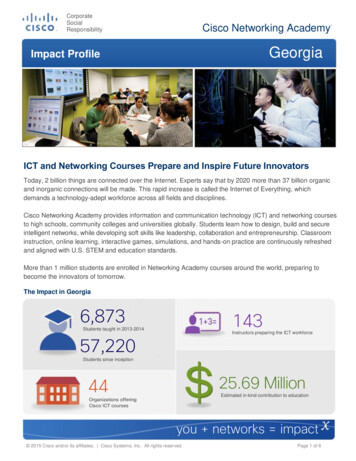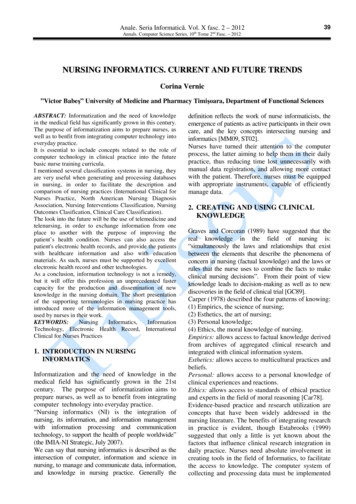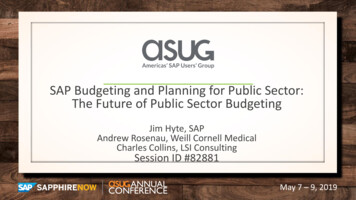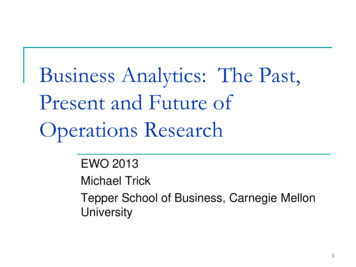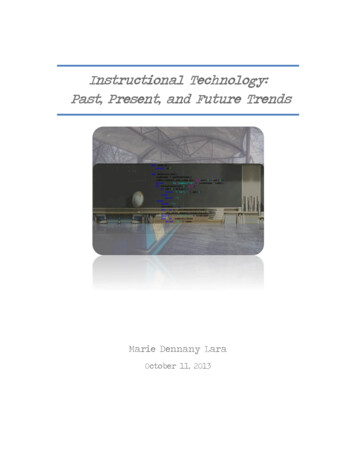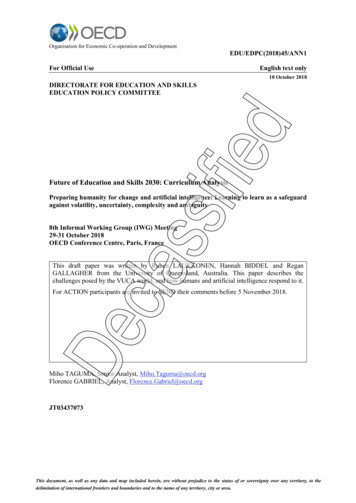
Transcription
Organisation for Economic Co-operation and DevelopmentEDU/EDPC(2018)45/ANN1For Official UseEnglish text only10 October 2018DIRECTORATE FOR EDUCATION AND SKILLSEDUCATION POLICY COMMITTEEFuture of Education and Skills 2030: Curriculum AnalysisPreparing humanity for change and artificial intelligence: Learning to learn as a safeguardagainst volatility, uncertainty, complexity and ambiguity8th Informal Working Group (IWG) Meeting29-31 October 2018OECD Conference Centre, Paris, FranceThis draft paper was written by Ruben LAUKKONEN, Hannah BIDDEL and ReganGALLAGHER from the University of Queensland, Australia. This paper describes thechallenges posed by the VUCA world, and how humans and artificial intelligence respond to it.For ACTION participants are invited to SEND their comments before 5 November 2018.Miho TAGUMA, Senior Analyst, Miho.Taguma@oecd.orgFlorence GABRIEL, Analyst, Florence.Gabriel@oecd.orgJT03437073This document, as well as any data and map included herein, are without prejudice to the status of or sovereignty over any territory, to thedelimitation of international frontiers and boundaries and to the name of any territory, city or area.
2 EDU/EDPC(2018)45/ANN1Table of contentsAbstract . 31.Introduction . 41. PART 1: VUCA . 61.1. The Predictive Brain . 61.2. Humans . 71.3. Machines . 91.4. Summary of Part 1 . 122. PART 2: Agency . 132.1. Humans . 132.2. Machines . 152.3. Summary of Part 2 . 163. Discussion . 174. Concluding Remarks . 19References . 20FiguresFigure 1. The exponential progress of computing power . 4Figure 2. Perceptual illusions: the power of the predictive brain . 6Figure 3. Decision making by human and machine intelligence. . 10Figure 4. Reinforcement learning . 15FUTURE OF EDUCATION AND SKILLS 2030: CURRICULUM ANALYSISFor Official Use
EDU/EDPC(2018)45/ANN1 3AbstractIn this paper, we describe the challenges posed by VUCA: Volatility, Uncertainty,Complexity, and Ambiguity. We begin by providing a brief review of human behaviourand decision making in VUCA situations. In doing so, we hope to illustrate how humanminds and brains typically respond in unpredictable situations, and then based on thisreview, provide some recommendations about how to prepare for an increasingly dynamicworld. We then compare human and machine abilities. The comparison to “intelligent”machines is valuable because it highlights the specific human capacities that are not easilyreplicated in computers. The challenge of building artificial intelligence (AI) also revealsimportant insights into the human skills and competencies that are likely to be important inthe future. The distinguished fellow at the Institute for the Future, and best-selling author,Bob Johansen (2013[1]), said that, “The ultimate dilemma is to take the VUCA world andchange it from a threatening thing, which it certainly is, into a world that is not onlythreatening but also laden with opportunity.” To this end, we provide actionable methodsfor individuals and society to become robust and adaptable to many future outcomes andpossible opportunities.FUTURE OF EDUCATION AND SKILLS 2030: CURRICULUM ANALYSISFor Official Use
4 EDU/EDPC(2018)45/ANN11. IntroductionTechnology is progressing exponentially fast. Gordon Moore (1975[2]) observed thatcomputing power (defined by the number of transistors per integrated circuit) was doublingapproximately every two years, a pattern that remains consistent to this day (known as“Moore’s Law”). If the trend continues, the processing capacity of machines will surpassthe capacity of the human brain, and continue well beyond; each year making more progressthan it did the year before (this intimidating process is illustrated in Figure 1). Exponentialprogress is notoriously difficult for humans—who are adapted to thinking linearly—toappreciate (Wagenaar and Sagaria, 1975[3]). Technology and society are heavilyinterconnected, so faster changes in technology often translate to faster changes in society.Moreover, change, more often than not, translates to greater unpredictability in the form ofVUCA. To the human mind that is seeking to make sense of the world, this is a potentiallytroubling state of affairs (as we will soon see). With growing automation, machines alsohave the potential to take away the pursuits that bring meaning and purpose to the lives ofmillions of people—their careers, their passions, and their way of life. While it is clear thatthere are potential costs to technological progress, there are also many benefits. Technologycan transform society for the better by improving decision-making, healthcare, transport,security, and education. Artificial intelligence can liberate humans from many tasks thatwould ordinarily be demanded of them, potentially returning us to a society that is “timerich” instead of “time poor”. The key then, is in making the most of the benefits while beingwell prepared for the hazards.Figure 1. The exponential progress of computing powerThis figure shows the exponential progress of computing power from 1900 to 2013, with projections into2025, where artificial intelligence is projected to parallel the processing capacity of the human brainSource: Figure adapted from (Kurzweil, 2005[4])FUTURE OF EDUCATION AND SKILLS 2030: CURRICULUM ANALYSISFor Official Use
EDU/EDPC(2018)45/ANN1 5The acronym VUCA has been used often in the context of leadership theories (Pasmoreand O'Shea, 2010[5]), and the US Army originally used the term to refer to the increasinglyVUCA-esque world following the Cold War (Bennis and Nanus, 1985[6]). What are thedifferent aspects of VUCA? Volatility is the liability of something to change rapidly andunpredictably. Stock markets, for example, are considered volatile because of how quicklythey change and therefore how notoriously challenging they are to predict. Uncertaintyrelates to the quality of information one has—or the degree to which the outcome of anevent is knowable in advance. Complexity increases when there is a greater number ofrelevant variables or interrelationships; the more variables, the more complex the situation.For instance, managing a classroom with five children is much less complicated thanmanaging 100, and doing so is simpler if each student speaks the same language. Ambiguityoccurs when an event, situation, or context is unclear, either because information ismissing, inconsistent, contradictory, or obscured in some way. For humans—and indeedmachines—each of these components of VUCA ultimately make for a less predictableworld.The following paper is divided into two parts (1: VUCA and 2: Agency), followed by ageneral discussion. Part 1 begins with a succinct introduction to a theory of the brain knownas predictive processing. The aim here is to provide scaffolding for understanding howhumans respond in VUCA situations. We then briefly review the psychology, neurochemistry and neuro-physiology literature to evaluate the negative and positiveconsequences of VUCA for human well-being. We then consider how people can learn torespond to VUCA effectively. In the final section of Part 1, we provide a broad overviewregarding the current state of artificial intelligence (AI)—including specific and generalAI—and then discuss how autonomous machines perform in VUCA situations. In Part 2,we turn our attention to Agency, and consider the possibility that a sense of agency mightserve a valuable function for humans in uncertain situations. We also consider whether theprocesses that underlie autonomy in machines resemble primitive forms of agency, andwhether AI is prepared for morally ambiguous situations. In the general discussion, wesynthesise the review and propose that a malleable attribute of humans—their ability tolearn new skills and apply meta-learning principles—will be particularly valuable forensuring that humans can adapt to change in a VUCA world. We suggest that one of thekey goals of education ought to be to prepare students to be adaptable learners equippedwith meta-learning skills (Maudsley, 1980[7]), so that when inevitable changes occur,people and communities are robust enough to adopt new skills and practices, andeffectively transfer learning across situations. Meta-learning capacities may also helpprovide a sense of agency and self-efficacy in an otherwise chaotic world—it may not bepossible to know what to expect, but it is perhaps possible to learn how to respond whenthe unexpected occurs.FUTURE OF EDUCATION AND SKILLS 2030: CURRICULUM ANALYSISFor Official Use
6 EDU/EDPC(2018)45/ANN11. PART 1: VUCA1.1. The Predictive BrainTo understand how brains and minds respond to VUCA situations, it is useful to have abasic idea of how the brain works. A sense for human psychology is also valuable for latersections discussing AI, because the mind sciences and machine intelligence research arehighly complementary (insights in one field often lead to insights in the other). Althoughthere exists much debate on specific questions about how the mind and brain achievecertain feats, there are basic processes that are reasonably well agreed upon amongscientists, and this short section focuses on these latter cases. There is no doubt, forexample, that the way we perceive and experience the world is different from the way itactually is. That is to say, we do not see the world objectively; we see it based on a particularkind of interpretation that is constrained by our biology, developmental history, culture,and evolution. As a biological constraint, we have certain kinds of eyes that can onlyprocess certain kinds of information. Relative to the mantis shrimp for example—whichhas eyes that can move independently and can perceive ultraviolet light (Marshall andOberwinkler, 1999[8])—human vision is highly constrained (and our other senses aresimilarly limited). Our minds further constrain and influence our perceptions, as evidencedby visual illusions:Figure 2. Perceptual illusions: the power of the predictive brainTo most people, the figure on the left initially looks like a series of dots lacking any particular meaning, andthe figure on the right looks like a frog.Notice any first impressions of the images, and then how they can change with a simpleupdate to expectations (in cognitive science these are called predictions). The figure on theleft can suddenly appear as a dog sniffing the ground, if one is looking for it. And theapparent frog in the other figure, if you tilt your head to the right, can suddenly reveal a‘hidden’ horse. There is of course no true interpretation of the image—the visualinformation does not inherently contain a dog or a frog or a horse—but the predictions thatwe make drive what we perceive. We often face similarly ambiguous situations at night,where the mind needs to make sense of a confusing interaction of shadows and movement,for example, in order to distinguish whether there is a bat or a squirrel in a tree, or if it isjust the wind. It is easy to appreciate how our predictions shape our perceptions in theseFUTURE OF EDUCATION AND SKILLS 2030: CURRICULUM ANALYSISFor Official Use
EDU/EDPC(2018)45/ANN1 7ambiguous environments, but perhaps more difficult to admit that all perception isessentially a product of our predictions. In some cases, our perceptions are such goodpredictors of the sensory environment that they seem very real, and so we have a lot ofconfidence in them. For example, there is little ambiguity between cars and trees, and sotheir consistency and obviousness make it hard to believe that the perception is in fact aprediction, just like the Dalmatian dog in Figure 2. The predictive processing view of thebrain is influenced by a long list of prominent theories and researchers (possibly going backto Immanuel Kant (Swanson, 2016[9]), but is most famously polished in the work ofneuroscientist Karl Friston (2003[10]), and the philosophers Andy Clarke (2013[11]
Organisation for Economic Co -operation and Development EDU/EDPC(2018)45/ANN 1 For Official Use English text only 10 October 2018 DIRECTORATE FOR EDUCATION AND SKILLS EDUCATION POLICY COMMITTEE Future of Education and Skil ls 2030: Curriculum Analysis Preparing humanity for change and artificial intelligence: Learning to learn as a safeguard against volatility, uncertainty,

